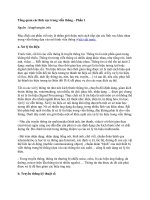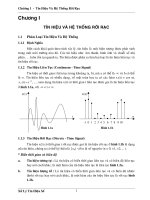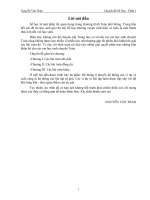ELECTROMECHANICAL DESIGN HANDBOOK phần 1 doc
Bạn đang xem bản rút gọn của tài liệu. Xem và tải ngay bản đầy đủ của tài liệu tại đây (104.99 KB, 10 trang )
ELECTROMECHANICAL
DESIGN HANDBOOK
Ronald A. Walsh
Manager, Research and Development
Powercon Corporation
Severn, Maryland
Third Edition
McGRAW-HILL
New York San Francisco Washington, D.C. Auckland Bogotá
Caracas Lisbon London Madrid Mexico City Milan
Montreal New Delhi San Juan Singapore
Sydney Tokyo Toronto
Library of Congress Cataloging-in-Publication Data
Walsh, Ronald A.
Electromechanical design handbook / Ronald A. Walsh. — 3rd ed.
p. cm.
ISBN 0-07-134812-3
1. Electromechanical devices—Design and construction—Handbooks,
manuals, etc. I. Title.
TJ163.W35 1999
621—dc21 99-4487
CIP
Copyright © 2000 by The McGraw-Hill Companies, Inc. All rights reserved. Printed in
the United States of America. Except as permitted under the United States Copyright
Act of 1976, no part of this publication may be reproduced or distributed in any form or
by any means, or stored in a data base or retrieval system, without the prior written per-
mission of the publisher.
1234567890 DOC/DOC 90987654
ISBN 0-07-134812-3
The sponsoring editor for this book was Linda Ludewig, the editing supervisor was
M. R. Carey, and the production supervisor was Pamela A. Pelton. It was set in Times
Roman by North Market Street Graphics.
Printed and bound by R. R. Donnelley & Sons Company.
This book is printed on acid-free paper.
McGraw-Hill Books are available at special quantity discounts to use as premiums and
sales promotions, or for use in corporate training programs. For more information,
please write to the Director of Special Sales, McGraw-Hill, 11 West 19th Street, New
York, NY 10011. Or contact you local bookstore.
Information contained in this work has been obtained by The McGraw-
Hill Companies, Inc., from sources believed to be reliable. However,
neither McGraw-Hill nor its authors guarantee the accuracy or com-
pleteness of any information published herein, and neither McGraw-Hill
nor its authors shall be responsible for any errors, omissions, or damages
arising out of use of this information. This work is published with the
understanding that McGraw-Hill and its authors are supplying informa-
tion but are not attempting to render engineering or other professional
services. If such services are required, the assistance of an appropriate
professional should be sought.
ABOUT THE AUTHOR
Ronald A. Walsh was director of research and development at the Powercon Cor-
poration in Severn, Maryland for 20 years. An industrial product designer for more
than 45 years with such companies as Bendix Radio, American Machine and
Foundry, and Martin Marietta, he holds three U.S. patents for electronic packaging
systems and mechanical devices and five copyrights. Ronald Walsh worked at Cape
Canaveral, Florida, as a liaison engineer on the Titan and Gemini aerospace vehicles
and participated in the design of the Titan, Gemini, and Apollo aerospace vehicles
and numerous manned military and commercial aircraft and military guided mis-
siles. He has worked with some of the pioneers of advanced aircraft and aerospace
vehicle design, atomic energy processing equipment, and military and commercial
electrical and electronic equipment. He is the author of the McGraw-Hill Machining
and Metalworking Handbook.
ACKNOWLEDGMENTS
In the course of compiling data and procedures for inclusion in this handbook, I selected data,
design information, and design procedures from many sources. I wish to express my gratitude
particularly to the following individuals, companies, and organizations who granted permis-
sion to use their copyrighted design data or otherwise contributed to the production of this
handbook: Ralph Siegel, president, Powercon Corporation (Severn, Maryland 21144); Alex
Feygelman, design engineer; Katrina T. Walsh; Michelle E. Walsh; Exide Corporation; THE
TIMKEN COMPANY; Boston Gear Division of IMO Industries; ALCOA (Aluminum Com-
pany of America). I am grateful also to the following societies, institutes, and specification
authorities: AISC; SMI; ANSI; ASME; AGMA; NEMA; AISI; AFBMA; IFI; ASTM; SAE;
Newark Electronics; Allied Electronics; Tandy Corporation; Bryant Electric—Division of
Westinghouse; Thermometrics, Inc.; Machine Design, a Penton publication; The Chemical
Rubber Publishing Company; Omega Engineering; T. B. Wood’s Sons, Inc.; WATLOW, Inc.;
Eastman Kodak Company; Waldes Truarc; Tinnerman Co.; Ruland Co.; PEM Inc.; Linda
Ludewig, Chief Editor, McGraw-Hill, Inc.; and Larry S. Hager, Senior Editor, McGraw-
Hill, Inc.
xxi
PREFACE
This third edition of the Electromechanical Design Handbook is again presented as a useful
working tool for product designers, design engineers, and others who are involved directly in
the product design disciplines and those in the design support groups throughout industry.
The data in this handbook cover a broad range of subjects because of the nature of elec-
tromechanical design engineering practice.
Product designers who possess general and specific practical engineering knowledge are
valuable to their particular company or organization. Those who have a broad range of prac-
tical electromechanical design knowledge not only are more secure in their jobs but can
acquire the ability to find new jobs more easily and quickly if the need arises.
I have tried to consolidate enough basic and application-specific design data and proce-
dures to allow the electromechanical designer to initiate many of the design calculations and
procedures required to begin the development of mechanical, electrical, and electronic parts,
mechanisms, assemblies, and processes. Most of the equations and techniques presented in
this handbook have been previously used and accepted as standard practice throughout
industry. At the same time, the experienced designer and student should understand that
mathematical solutions to complex industrial design engineering problems are approxima-
tions at best in many cases. The mathematical solutions to problems in some areas of design
are exact, while the solutions in others are unattainable with standard analytical procedures.
There are no problem solution substitutes more effective than the prototype and definitive
testing in proving the adequacy of a particular design or product. Some products cannot have
a prototype stage, and in these cases we rely upon accepted standards and procedures formu-
lated by the American standards organizations, and calculations and experience. The proto-
type and testing stages of product design are of prime importance to the industrial
electromechanical product designer.
The intent of this handbook is to show practical, working design data and procedures; lit-
tle emphasis is placed on theory. Successful industrial design engineers do not dwell on the-
ory; rather, they use their practical engineering training, their intelligence, and testing and
experience to solve actual industrial design problems quickly and effectively, with any means
at their disposal. This handbook does not attempt to cover all subjects relevant to design engi-
neering, only those that are used in most common and some specialized electromechanical
design applications.
This third edition contains an expanded amount of information and design data that will
prove even more useful than the first edition, which was so widely accepted in the design engi-
neering community.
For those designers who are interested in or must have information concerning the manu-
facturing practices and processes directly related to electromechanical design engineering
practices and also modern manufacturing procedures, the author recommends his McGraw-
Hill Machining and Metalworking Handbook (1999), which, together with the McGraw-Hill
Electromechanical Design Handbook, gives the product designer or design engineer an
unprecedented amount and source of practical and effective design procedures and data, as
well as manufacturing procedures and industrial processes.
American industry today, more than ever, needs people in the engineering professions
who are trained in the multiple integrated disciplines of mechanical, electrical, and electronic
xix
engineering design practices (called electromechanical design engineering, not mechatronics).
See the introduction to Chap. 6 and its contents for how to effectively implement these disci-
plines. America needs more highly trained electromechanical design engineers and fewer spe-
cialists in order to more effectively compete in the national and international markets. This
has been the author’s purpose and goal in writing this volume and its companion, the
McGraw-Hill Machining and Metalworking Handbook.
Ronald A. Walsh
xx PREFACE
INTRODUCTION
If you are involved in the design of industrial, military, or consumer products and perform
mechanical, electrical, and electronic design functions, this handbook will be of value in your
work.
The handbook is not intended for specialists in the various engineering disciplines, but
rather for those designers who create the majority of general products, parts, mechanisms,
and assemblies used throughout industry.
The handbook does not attempt to show an individual how to be a designer, but does pre-
sent the basic reference data and techniques used to perform the various design functions.
The term electromechanical designer is appropriate today because many designers are
involved with components and assemblies that contain elements that are mechanical, electri-
cal, and electronic in nature, all dependently combined to form the finished product.
In many small companies, the electromechanical or product designer is responsible for
the entire product—all aspects included. It is to the designer’s advantage to be proficient in
or to have reference data pertaining to as many of the disciplines involved in product design
as possible.
Aside from containing a formidable amount of design data, the references listed in the bib-
liographies at the ends of chapters will be of assistance to many designers in carrying out their
work, as will the listings of specification and standards authorities shown in Chap. 15. As
stated in the handbook, the accumulation of accurate data is one of the basic design functions.
It was not my intent to show as many aspects of product design as possible, but to show
those methods and data that are used again and again in the course of product-design engi-
neering work. I have attempted to cover those subjects and areas which are of prime impor-
tance to the product designer, with emphasis on procuring additional information from
various expert sources, which have been listed.
The handbook also will be of value to students of engineering attending technical teaching
facilities, as it provides them with a good view of what is involved in modern product design
and how to approach many basic design problems.
Electromechanical designers today have many technological advantages over their prede-
cessors. In modern manufacturing facilities, the designer has access to accurate measuring and
testing equipment, computer-aided design stations, and high-speed and accurate manufacturing
equipment, such as computer-controlled machining centers and multistation punch presses, and
highly accurate sheet-metal cutting and bending machines. Facilities such as these allow parts to
be made consistently more accurately and at a higher rate of production than in the past.
Modern test and measuring equipment and devices, such as computers, digital oscillo-
scopes, digital multimeters and counters, pressure transducers, load cells, strain gauges, ther-
mocouples, accelerometers, and high-speed cameras, allow the modern designer to acquire
accurate answers to many design problems that would have been difficult or impossible to
solve mathematically in the past, and that are still beyond the scope of engineering design
manuals.
This equipment allows designers today to design and develop a particular product quickly,
send it onto its prototype stage, and run definitive tests to prove the adequacy and safety
of the design. Cost analyses can then be made and implemented, the prototype again tested,
and finally, the product set up for production after the engineering documentation has been
completed.
xxiii
Using this handbook will enable you to perform many preliminary design studies and cal-
culations that are necessary to define the basic requirements of the various parts, mechanisms,
and assemblies that represent or make up the designer’s concepts of the anticipated product.
On complex products, you will consult with specialists in the various engineering and sci-
entific disciplines who will assist you in your efforts. It is good design practice to also consult
the various manufacturers of purchased parts and the outside vendor producers of your
designed parts or processes, such as springs, castings, molded-plastic parts, gears, bearings,
plating, special finishes, and fabricating materials. These manufacturers are all willing and
able to assist the designer in their particular specialties.
As a conclusion to this introduction, it must be said that the majority of the credit for this
handbook is not due the author, but the thousands of individuals and companies who origi-
nated and developed the data and equations that fill the pages of this handbook. A consoli-
dation of all their efforts can only be beneficial to the practicing product designer and to
American industry.
xxiv INTRODUCTION
v
CONTENTS
Preface
xix
Acknowledgments xxi
Introduction xxiii
Chapter 1. Mathematics Reference and Measurement System Conversions 1.1
1.1. Plane Geometry
1.5
1.2. Transposing Equations
1.9
1.3. Algebraic Factors and Expansions
1.10
1.3.1. Imaginary Numbers / 1.12
1.3.2. Complex Numbers / 1.12
1.3.3. Trigonometric Form of a Complex Number / 1.12
1.3.4. Radicals / 1.12
1.3.5. Factorials / 1.14
1.3.6. Ratios and Proportions / 1.14
1.3.7. Summation / 1.14
1.3.8. Permutations, Combinations, and Progressions / 1.14
1.3.9. Quadratic Equations / 1.15
1.3.10. Cubic Equations / 1.15
1.3.11. General Quartic Equations / 1.16
1.4. Powers-of-Ten Notation 1.17
1.5. Logarithms 1.17
1.6. Binomial Formula 1.19
1.7. Determinants 1.19
1.7.1. Second-Order Determinants / 1.19
1.7.2. Third-Order Determinants / 1.20
1.8. Trigonometry 1.21
1.8.1. Functions of Angles in a Right Triangle / 1.21
1.8.2. Signs and Limits of Trigonometric Functions / 1.21
1.8.3. Equivalent Expressions (Identities) / 1.21
1.8.4. Solution of Triangles / 1.23
1.9. Analytic Geometry 1.27
1.9.1. Straight-Line Equations / 1.28
1.9.2. Linear Functions of Lines / 1.28
1.9.3. Equations of the Common Geometric Forms / 1.30
1.9.4. Relating Rectangular and Polar Coordinates / 1.30
1.9.5. Other Useful Curves / 1.30
1.10. Basic Calculus 1.33
1.10.1. Derivatives / 1.33
1.10.2. Differentiation Formulas for Algebraic Functions / 1.34
1.10.3. Differentiation Formulas for Transcendental Functions / 1.35
1.10.4. Applications of the Derivative / 1.35
1.10.5. Integrals and Integration / 1.38
1.10.6. Other Useful Integration Formulas / 1.39
1.10.7. Partial Derivatives / 1.40
1.10.8. Differentials / 1.42
1.10.9. Double or Iterated Integrals / 1.43
1.11. Percentages, Compound-Interest Calculations, and Engineering Economics 1.44
1.11.1. Percentages / 1.44
1.11.2. Compound Interest / 1.45
1.11.3. Engineering Economics / 1.46
1.12. The Involute Function 1.46
1.12.1. Involute Geometry / 1.47
1.12.2. Plotting the Involute Curve / 1.49
1.13. U.S. Customary and Metric (SI) Measures and Conversions
1.49
1.14. Temperature Systems 1.49
1.15. Mathematical Signs and Symbols 1.50
1.16. Factors and Prime Numbers 1.51
1.17. Newton’s Method for Solving Intractable Equations 1.51
1.18. The Greek Alphabet 1.68
1.19. Decimal Chart 1.68
1.20. Degrees and Radians Chart 1.68
Chapter 2. Practical Engineering Mechanics 2.1
2.1. Definitions and Basic Units of Mechanics 2.1
2.2. Statics 2.3
2.2.1. Resolution of Forces at 90° / 2.3
2.2.2. Resolution of Forces Not at 90° / 2.3
2.2.3. Resolution of Noncoplanar Forces / 2.4
2.2.4. Coplanar Force Systems / 2.5
2.2.5. Noncoplanar, Concurrent Force Systems / 2.6
2.2.6. Graphical Resolution of Coplanar Forces / 2.7
2.2.7. Systems in Equilibrium / 2.9
2.3. Dynamics
2.13
2.3.1. Moments of Inertia / 2.13
2.3.2. Polar Moments of Inertia of Areas / 2.13
2.3.3. Polar Moments of Inertia of Masses / 2.13
2.3.4. Moments of Complex Areas and Masses / 2.14
2.3.5. Transfer of Axes / 2.15
2.3.6. Approximate Calculations for I / 2.15
2.3.7. Moments of Plane Areas by Integration / 2.16
2.3.8. Section Modulus / 2.17
2.3.9. Radius of Gyration / 2.18
2.3.10. Center of Percussion / 2.18
2.3.11. Center of Gravity / 2.19
2.3.12. Acceleration Resulting from Unbalanced Forces / 2.19
2.3.13. Rectilinear Motion with Constant Velocity / 2.19
2.3.14. Rectilinear Motion with Constant Acceleration / 2.20
2.3.15. Rotary Motion with Constant Acceleration / 2.21
2.3.16. Torque and Angular Acceleration / 2.22
2.3.17. Kinetic Energy / 2.23
2.3.18. Potential Energy / 2.23
2.3.19. Force and Energy in a Force Field / 2.23
2.3.20. Work and Power / 2.24
2.3.21. Centrifugal Force / 2.24
2.3.22. Conversions / 2.25
2.3.23. Mechanics in Product Design / 2.25
2.3.24. Impulse and Linear Momentum / 2.30
2.3.25. Angular Impulse and Momentum / 2.30
2.3.26. Symbols Used in Mechanics / 2.30
2.3.27. Constants / 2.32
2.3.28. Newton’s Method for Solving Intractable Equations / 2.32
2.3.29. Mechanics Conversions / 2.33
vi CONTENTS









